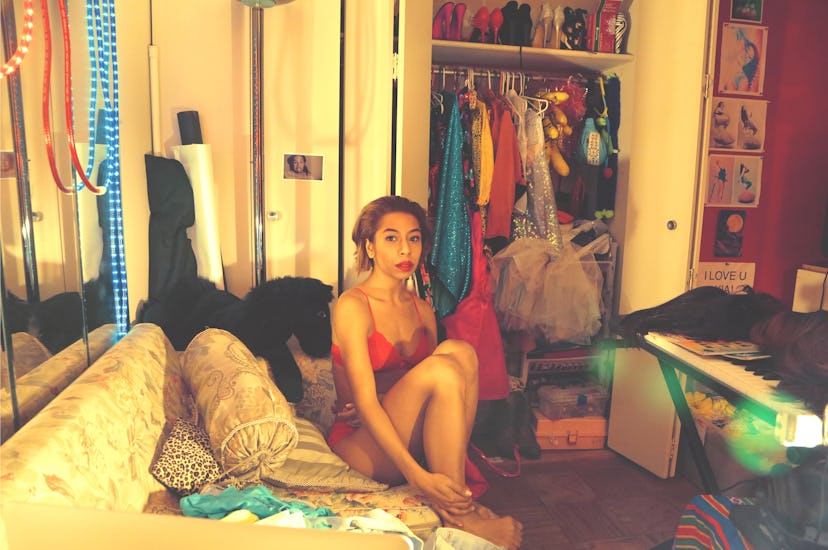For the artist Kia LaBeija, the key to self discovery is embracing all that life throws at you—from the momentary highs to the challenging experiences that might not be so fleeting. Over the past decade, Kia has worked across photography, film, and performance art, creating an oeuvre of deeply personal work that explores her identity as a queer woman born to a Black father and an Asian mother.
In her debut museum solo exhibition “Prepare My Heart,” which opened at Fotografiska New York on February 24, Kia continues to take full control of her narrative. Through self-portraiture, personal archival materials, and other contemporary photography, the artist chronicles her experiences of growing up in 1990s New York as a child with HIV, and explores the nuances of survival, legacy, and what it means to be “felt without touch” and “heard without sound.”
“Choosing to heavily focus on my experience with HIV was very intentional,” Kia says. “For the past few years I’ve felt like moving past that narrative in my work, but it’s something I live with. I can’t ignore it, or run from it. So I ran towards it.”
At the heart of the exhibition is the artist’s late mother, Kwan Bennett, an activist for women and children living with HIV who passed away in 2004 due to AIDS. Bennett’s life and advocacy work had an immeasurable impact on Kia, who attended rallies and speaking engagements with her mother as a child. The artist’s mother is seen smiling in all but one photograph in the show, where her eyes are closed in a moment of rest. The show also honors Kia’s time spent in New York’s Ballroom scene, including her role as the Overall Mother of The Royal House of LaBeija in its 50th year. Below, Kia shares details from some choice works featured at Fotografiska, which will be on view until May 8.
“I RISKED MY LIFE FOR YOU,” 2021; “SHE KNOWS AND SHE LOVES ME EVEN MORE,” 2021. Courtesy of Kia LaBeija.
“‘I risked my life for you’ is a term I heard many times from past sexual experiences or ex-relationships,” Kia says. “It made me feel unloveable, toxic and ugly, like there was something wrong with me that couldn’t be fixed. On the other side of that, I have found happiness in someone who found strength where I saw weakness. She said it made her love me even more. It’s very common for women living with HIV to deal with emotional and psychological abuse, intimate partner violence and sexual violence, and there needs to be more dialogue around that.”
“Love, Dad” 2004. Courtesy of Kia LaBeija
“I wanted to include my father in the show, but I didn’t want to speak for him, so I let him speak for himself. This was a letter he wrote to me the day after my mother died.”
“Me and Her Against the World,” 2018. Courtesy of Kia LaBeija.
“Yellow roses were my grandmother’s favorite flower. They became this mysterious and magical symbol of her once she died,” Kia says. “And when my mother died, there were yellow roses in the room—even petals spread on top of her body. To this day, I don’t know who did it or how. This is an image of my partner Taina and I. The photo represents the gifting of this significant representation of love and otherworldliness.”
“Mourning Sickness,” 2014. Courtesy of Kia LaBeija.
“‘Mourning Sickness’ is an image about mourning the loss of my mother and the effects of HIV medication. I wanted to create an image about both experiences through the lens of a beautiful, colorful and theatrical re-telling.”
“Eleven” 2015. Courtesy of Kia LaBeija.
“‘Eleven’ is an image taken in my doctor’s office,” Kia says. “He’s been seeing me since I was four years old. In the photo I am in my prom dress to honor that I have met many milestones that were not always guaranteed. My doctor let me shoot this image during a routine appointment and is actually drawing my blood in the photograph.”
“Jamil, One Night on the Pier” 2012; “Celso, One Night on the Pier,” 2012. Courtesy of Kia LaBeija.
“This is one of my favorite series of images. Celso and Jamil are two important figures in my life and in my photographs. Celso brought me into the nightlife and ballroom scenes. This was just a perfect New York moment, a hot summer night spent dancing and laughing among friends.”
“Our New Spokesperson, ACT UP,” 1994. Courtesy of Kia LaBeija.
“Untitled #7,” 2018. Courtesy of Kia LaBeija.
“Kwan and Kia Speaking at a Union Square Rally,” 1995. Courtesy of Kia LaBeija.
“I wanted to include these images as a reminder that there were, and still are, many children affected by the AIDS epidemic. And while we read in history books about the lives of the people we lost (predominantly all the men we lost,) there is an entire population that is non-existent. We are a hidden minority.”
